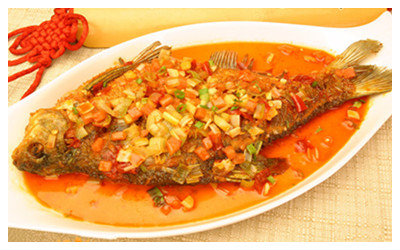Skype: neodalle-travel
Tel: +86 135 7447 2266
E-mail: sales@visitaroundchina.com

 Hubei Food began to develop its own unique style during the Warring State Period. Through development and change over the last 2,000 years, it has become today’s Hubei cuisine. Hubei food is famous for its freshwater fish dishes since almost every fish available in Hubei can be prepared into different dishes. There are all-fish, bream, Mandarin fish, eel, turtle, giant salamander, crab, shrimp, clam, water chestnut, lotus root, wild duck, and preserved – duck – egg dinners. Among the dishes, steamed bream without soy sauce, turtle with wax gourd, instant – boiled fish with tangerine pulp, and braised chicken with chestnuts are all well known.
Hubei Food began to develop its own unique style during the Warring State Period. Through development and change over the last 2,000 years, it has become today’s Hubei cuisine. Hubei food is famous for its freshwater fish dishes since almost every fish available in Hubei can be prepared into different dishes. There are all-fish, bream, Mandarin fish, eel, turtle, giant salamander, crab, shrimp, clam, water chestnut, lotus root, wild duck, and preserved – duck – egg dinners. Among the dishes, steamed bream without soy sauce, turtle with wax gourd, instant – boiled fish with tangerine pulp, and braised chicken with chestnuts are all well known.
Features of Hubei Food
An important feature of Hubei food is its blending of fish with other ingredients. The reason why a single variety of fish can be prepared into so many different dishes is that the cooks are very skilled at blending fish with other ingredients. Many of the famous dishes are prepared from two or more raw materials, giving prominence to the major ingredient while attaching importance to the auxiliary materials. For example, stewed turtle is a dish of turtle and pig’s spine, sauted three slivers consists of shredded pork tenderloin, shredded chicken and shredded pig’s stomach, and dragon and phoenix marriage is a mixture of eel and chicken. The names of the dishes indicate that Hubei dishes are prepared from more than one ingredient.
Cooking Methods of Hubei Food
The main cooking methods are steaming and simmering. Steaming has been well discussed earlier in this book. Simmering is used to cook dishes with soup. It is done this way: First, fry the major ingredients in oil with seasoning, then put them in an earthen pot and heat them over a low fire for a long time. The special features of Hubei dishes are crisp bones, tender meat, and thick, genuine soup that go well with rice.
Hubei food is divided into four schools: Jingnan, Xiangyang, Ezhou and Han- Mian (Wuhan and Mianyang). The Jingnan school is known for its braised and stewed game, Xiangyang is famous for meat dishes, Ezhou is well known for its vegetarian food, and Han–Mian is famous for its seafood, poultry, and meat dishes. The three steamed dishes in Mian-yang (steamed with rice flour, steamed with soy sauce and pickles, and steamed without soy sauce) are typical dishes of the Han–Mian school.
Food Culture of Hubei
Hubei is one of the birthplaces of Chinese and its ancient culture. In ancient Chu culture, the food style is mainly fresh and salty, which can date back to the ages of Qu Yuan. Porridge and soup were mostly favored. As the saying goes, “Drinking soup before meal each day keeps the doctor away." It has exerted great influence up to now. Besides, there are a lot of choices, such as in Sijimei Restaurant, steamed bun with gravy stuffing in Sijimei Restaurant, Soup in Xiaotaoyuan Restaurant, hot and dry noodles in Cailinji Restaurant, Dumpling in Tanyanji Restaurant, Shaomei in Shuixiangju Restaurant, Tangyuan in Wufangzhai Restaurant, Steamed Wuchang Fish in Wuchang Restaurant, and so on. The most famous were hot dry noodles.
Hubei cuisine consists of dishes from Wuhan, Jinnan, Xiangyun and Southeast Hubei. Wuhan cuisine originated in an area where there is a major-scale inland fishery. Fish is the main ingredient of many dishes, such as steamed Wuchang fish, penholder-like fish belly, brown-sauce-stewed fish and quick-boiled fish with oranges.Helong Banquet, also Long Street Banquet, is a banquet in which invited people gather to eat meals along a long table, is the highest etiquette for Dong ,Tujia and Miao people to serve guests Other typical local dishes include steamed triplet from Mianyang, chicken broth stewed in an earthen jar, thousand-sliced pork, calipash soup with wax gourd and medicinal soups made by the long and gentle stewing of fried chicken with seasonings.
The word Guozao (meaning having breakfast outdoors) first appeared in the book Hankou Zhuzhi Ci during the Daoguang Period of Qing Dynasty. It refers to Wuhan people's having breakfast. Because of geographical environment and economic activities, people in Wuhan got used to the custom of Guozao outdoors a long time ago. The restaurants in Wuhan are highly developed, of various kinds, and of styles of both north and south. They are scattered in many streets all over the city, prosperous and crowded. According to statistiques, as many as 100, 1000 people are engaged in the business. Guozao has been in the noticeable characteristic in this city.
 Ask Questions ?
Ask Questions ?